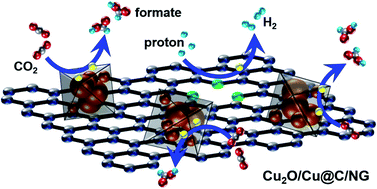Selective CO2-to-formate electrochemical conversion with core–shell structured Cu2O/Cu@C composites immobilized on nitrogen-doped graphene sheets†
Abstract
The electrochemical conversion of CO2 into fuels and chemicals attracts worldwide attention for tackling global warming and energy crises. However, the efficiencies and selectivities for targeted products such as formate are still far from satisfactory. Herein, core–shell structured Cu2O/Cu@C immobilized on nitrogen-doped graphene sheets (Cu2O/Cu@C/NG) is prepared and used for CO2 reduction. Cu2O/Cu@C/NG yields higher activity towards formate in terms of a lower onset potential (−0.38 V versus RHE) and higher faradaic efficiency (82.1 ± 1.2%), as well as stable performance over 30 h. The enhancements in selectivity and activity are attributed to the synergistic effects between Cu sites and N doping, simultaneously improving CO2 adsorption and the interfacial charge transfer process. Additionally, N doping restrains hydrogen evolution on the copper sites, leaving more available sites for CO2 reduction. This study provides an efficient strategy to increase the activities of electrocatalysts for CO2-to-formate electroreduction.



 Please wait while we load your content...
Please wait while we load your content...